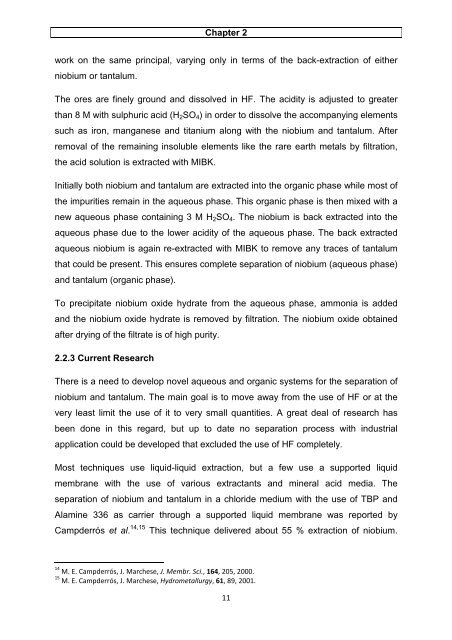A solution and solid state study of niobium complexes University of ...
A solution and solid state study of niobium complexes University of ...
A solution and solid state study of niobium complexes University of ...
You also want an ePaper? Increase the reach of your titles
YUMPU automatically turns print PDFs into web optimized ePapers that Google loves.
Chapter 2<br />
work on the same principal, varying only in terms <strong>of</strong> the back-extraction <strong>of</strong> either<br />
<strong>niobium</strong> or tantalum.<br />
The ores are finely ground <strong>and</strong> dissolved in HF. The acidity is adjusted to greater<br />
than 8 M with sulphuric acid (H2SO4) in order to dissolve the accompanying elements<br />
such as iron, manganese <strong>and</strong> titanium along with the <strong>niobium</strong> <strong>and</strong> tantalum. After<br />
removal <strong>of</strong> the remaining insoluble elements like the rare earth metals by filtration,<br />
the acid <strong>solution</strong> is extracted with MIBK.<br />
Initially both <strong>niobium</strong> <strong>and</strong> tantalum are extracted into the organic phase while most <strong>of</strong><br />
the impurities remain in the aqueous phase. This organic phase is then mixed with a<br />
new aqueous phase containing 3 M H2SO4. The <strong>niobium</strong> is back extracted into the<br />
aqueous phase due to the lower acidity <strong>of</strong> the aqueous phase. The back extracted<br />
aqueous <strong>niobium</strong> is again re-extracted with MIBK to remove any traces <strong>of</strong> tantalum<br />
that could be present. This ensures complete separation <strong>of</strong> <strong>niobium</strong> (aqueous phase)<br />
<strong>and</strong> tantalum (organic phase).<br />
To precipitate <strong>niobium</strong> oxide hydrate from the aqueous phase, ammonia is added<br />
<strong>and</strong> the <strong>niobium</strong> oxide hydrate is removed by filtration. The <strong>niobium</strong> oxide obtained<br />
after drying <strong>of</strong> the filtrate is <strong>of</strong> high purity.<br />
2.2.3 Current Research<br />
There is a need to develop novel aqueous <strong>and</strong> organic systems for the separation <strong>of</strong><br />
<strong>niobium</strong> <strong>and</strong> tantalum. The main goal is to move away from the use <strong>of</strong> HF or at the<br />
very least limit the use <strong>of</strong> it to very small quantities. A great deal <strong>of</strong> research has<br />
been done in this regard, but up to date no separation process with industrial<br />
application could be developed that excluded the use <strong>of</strong> HF completely.<br />
Most techniques use liquid-liquid extraction, but a few use a supported liquid<br />
membrane with the use <strong>of</strong> various extractants <strong>and</strong> mineral acid media. The<br />
separation <strong>of</strong> <strong>niobium</strong> <strong>and</strong> tantalum in a chloride medium with the use <strong>of</strong> TBP <strong>and</strong><br />
Alamine 336 as carrier through a supported liquid membrane was reported by<br />
Campderrós et al. 14,15 This technique delivered about 55 % extraction <strong>of</strong> <strong>niobium</strong>.<br />
14 M. E. Campderrós, J. Marchese, J. Membr. Sci., 164, 205, 2000.<br />
15 M. E. Campderrós, J. Marchese, Hydrometallurgy, 61, 89, 2001.<br />
11
















